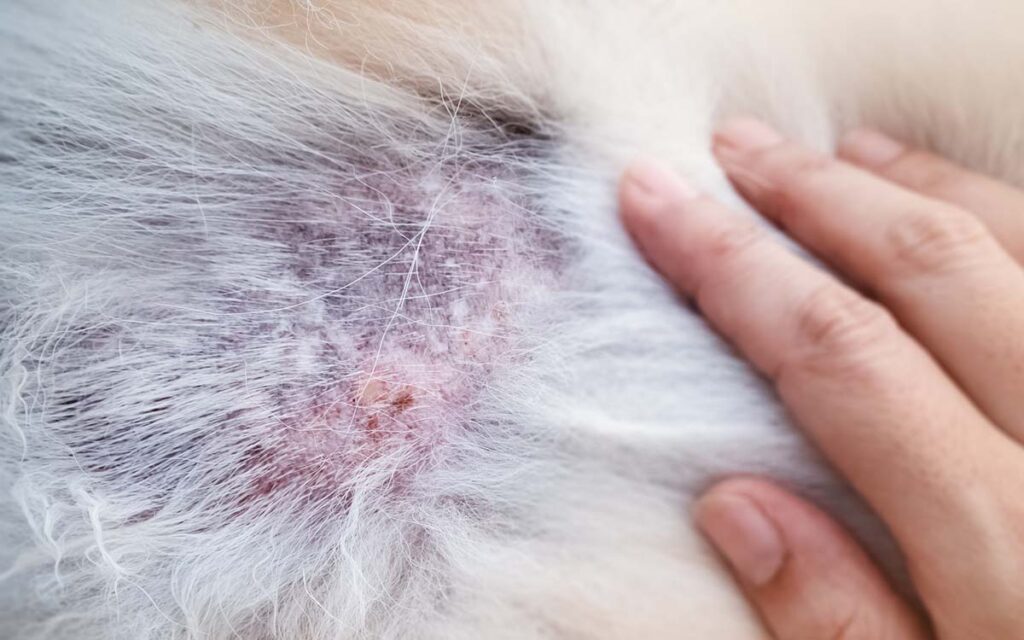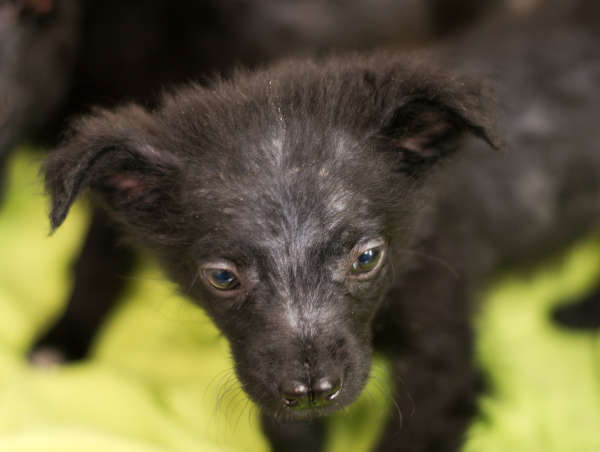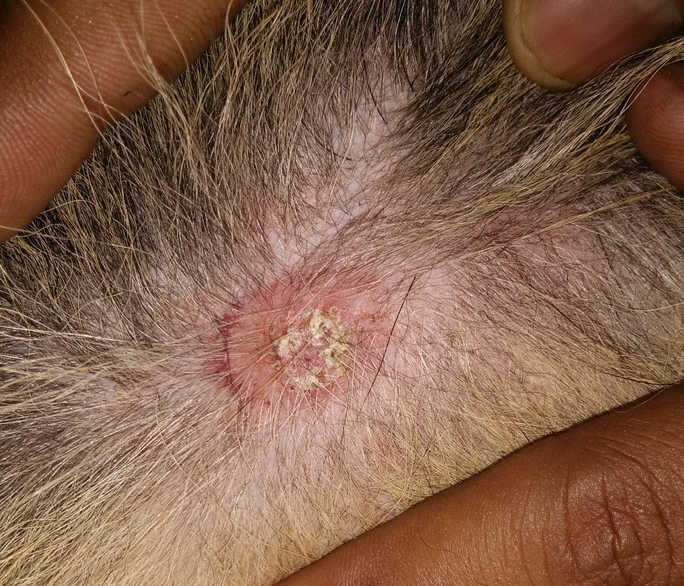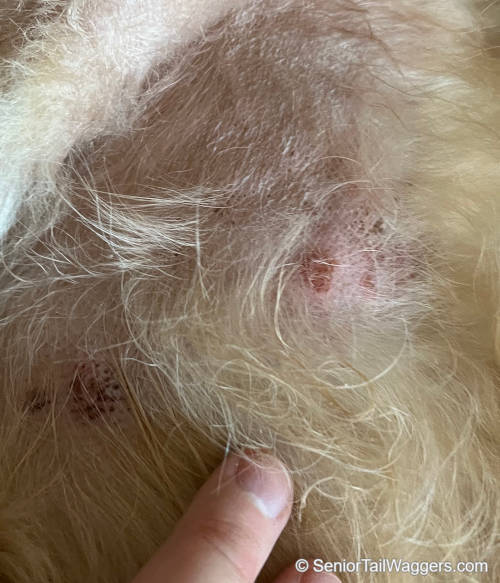
This article was updated on October 22nd, 2023

Skin lesions and sores come in different shapes and sizes, and some can be more harmful than others. In this article, we’ll cover common types, along with pictures, and discuss when it’s necessary to take your dog to the vet.
13 Common Types of Skin Lesions in Dogs
Skin lesions refer to any area of skin that looks different from the skin surrounding it. A lesion or sore can be an abnormal growth, wound, rash, or infection, just to name a few. The most common types found in dogs are the following:
1. Lumps and Bumps
Many dog parents will see a lump and immediately think of the word cancer (read my related article on skin lesions due to cancer). However, many lumps and bumps are benign and usually nothing to worry about. Therefore, it is important to investigate each growth to know what you are up against.



In general, lumps that are growing rapidly or changing in shape or appearance can indicate a more sinister underlying cause. Cancerous cells are constantly replicating and mutating, and therefore by definition, a malignant mass will be changing frequently.
Read our article about Lumps and Bumps.
2. Allergic skin rashes (allergic dermatitis)
Dermatitis is an inflammation of the skin due to allergies, causing areas of skin affected to become red, flaky, thickened, and itchy. Excessive rubbing and irritation can lead to hair loss, and the breakdown of the skin barrier allows bacteria to set up secondary infections, resulting in further damage.
Allergic skin reactions:



Allergic dermatitis is often due to a genetic predisposition that leaves dogs allergic to things such as:
- food,
- parasites, and
- environmental pollens.
Repeated exposure to the allergen will cause chronic damage to the skin over time and results in a very itchy, irritated, and sad dog. Dogs with repeated signs of dermatitis should have potential allergens investigated and eliminated.
Learn more about Skin Allergies and Rashes.
3. Red Skin Issues
As veterinarians, we see multiple dogs every week with red spots or rashes. Luckily, we can typically determine the cause and formulate a treatment plan that will have dogs feeling better quickly. A lot of red spots can be the result of allergic dermatitis (as we have just covered), but other possible causes include parasites, toxin exposure, bleeding under the skin, and autoimmune conditions.
Read More About Red Skin Issues or Belly Rashes.



4. Folliculitis
Resulting in sores, scabs, and bumps, folliculitis is a bacterial infection of the hair follicles from which your dog’s fur grows. The follicles become inflamed, and the surrounding skin becomes scaly, as shown on the picture below.

Dogs affected with folliculitis will often have lesions in areas where the fur is thinnest, and the overall coat quality may be dull and poor.
Read more about Folliculitis.
5. Hot Spots
Hot spots, as the name suggests, are discrete isolated inflamed and moist lesions. The surrounding areas of fur are typically wet. There can be various causes of hot spots including bacterial infections, insect bites, and allergies.



View more Pictures of Hot Spots with treatment information.
6. Tick or flea scabs
Easily mistaken for skin tags, ticks are parasites that feed on a dog’s blood by burying their heads under the skin. They are often painful and can cause inflammation in the surrounding tissues. Ticks can also transmit diseases such as Lyme disease and Ehrlichiosis, and a severe tick infestation can result in anemia from blood loss.
Read more about Tick Scabs.

Below is a picture of dog skin after flea bites. Fleas are hard to spot, but their droppings or eggs can usually be spotted in a dog’s coat. Dogs with fleas will typically excessively lick, scratch, or even have scabs or hot spots.
Read more about Flea Allergy and Flea Scabs.

7. Mange / dog mites
Mange is an infestation of the skin by mites that may result in itchiness, sore skin, and hair loss. The mites damage the fragile cells on the surface of the skin, and in some cases such as demodectic mange, the mites can burrow deep into the hair follicles interfering with hair growth.
Read more about Mange (Dog Mites).



8. Hair loss (alopecia)
While a dog’s coat may naturally thin at certain times of the year, complete areas of baldness are not normal and can indicate an underlying health condition. There are many causes of alopecia including stress, hormonal disease, self-trauma, external parasites, and poor nutrition. If your dog’s hair isn’t growing back, then you should have them seen by your veterinarian.
Read More About Hair Loss Spots.

9. Ringworm
Ringworm is a type of fungal infection that infects the skin in circular lesions. This results in soreness and hair loss. It is an infection that can spread fast and can even pass to humans.



Your veterinarian will be able to perform various tests to determine whether a fungus is the cause of your dog’s lesions and treat it accordingly.
View more Pictures of Ringworm.
10. Black spots on skin
One condition that I commonly see in my veterinary practice is discolored or black areas on the skin. Most instances of dark or black spots on the skin of dogs are hyperpigmentation. Hyperpigmentation occurs when there is an increase in dark pigmentation of the skin.



Photo: © Ian Brett Spiegel VMD, MHS, DACVD
The pigment of skin cells is what gives the skin its color. The substance in these cells that make this color is called melanin. Specialized cells in the skin produce melanin. If these cells become damaged, it may affect melanin production.
Read more about Black Spot Issues.
11. Flaky lesions
Often, flaky skin is nothing to worry about. Just like humans, dogs can get flaky skin. Giving your dog fatty acid supplements or using moisturizing shampoo may help. However, flaky skin can also be an indication of something more serious going on with your dog, including allergies, mange, autoimmune disorders as well as other skin conditions. If flaky skin persists, makes your dog uncomfortable or if you observe other symptoms, consult your veterinarian.
Read more about Dry Flaky Skin Issues in Dogs.

12. Scabs
One other common problem that we often encounter as veterinarians is the presence of scabs (serous crusts) on a dog’s skin. Scabs form over irritated and compromised skin and serve as protection from bacteria and infection, like a band-aid. Scabs can be the result of trauma (an injury), but they can also be caused by a health issue, such as a skin infection or an allergy.
Read more about Scabs on Dogs.



13. Lick granulomas
When a Dog licks excessively at their skin, this can lead to the skin being broken down and an ulcer or sore forming. Over time, this skin can thicken to form a granuloma. Causes include allergies, boredom or stress. The breeds I see more lick granulomas in include those prone to behavioral issues such as the Border Collie and Australian Shepherd.

The mainstay of treatment is to stop the licking, which can include the use of a buster collar and addressing the underlying behavioral issues.
We can keep the skin clean with salt water and prevent infections by using products such as Leucillin sprays. I find these sprays particularly effective when the lesions are still small and superficial. A vet check is wise as dogs often benefit from local creams that co
What skin lesions should you worry about?
Pay special attention to any of the following:
1. Any dramatic changes in your dog’s skin or the sudden appearance of sinister-looking lesions should be investigated as soon as possible.
2. If any lesions are causing your dog a lot of discomfort or resulting in them causing themselves a lot of self-trauma, then veterinary intervention is likely required.
3. It’s also important to pay attention to how your dog is as a whole. If they are unwell in themselves or if you’ve noticed any other changes in their behaviors or habit, then you should take them to the veterinarian.
Treatments
The treatment will depend very much upon which lesion or sore is present.
Lumps and bumps: Lumps and growths should be tested if they are changing in shape or size. Cancerous lumps should be removed, and, in some cases, chemotherapy may be an option. Benign lumps can be removed if they are causing your dog discomfort. Your first step is likely a biopsy to confirm the nature of the lump.
Allergies: allergies require the removal of the underlying allergen if possible, such as switching to a hypoallergenic diet in the case of food allergy. Some allergens cannot be avoided, however, so anti-itch medication may be prescribed to your dog, and any secondary bacterial infections treated with antibiotics.
Bacterial skin infections such as folliculitis and hot spots may be treated with antibiotics, steroids, and topical shampoo treatments.
Parasitic infestations require anti-parasitic medications. Ticks should be removed by your veterinarian so as to not leave the tick’s head in your dog’s skin.
Ringworm is treated with a long course of anti-fungal medication which can be given to your dog orally or applied topically depending on the extent of the infection.
Hair loss: hair loss can be indicative of many causes, many of which are the issues listed above. Once these have been ruled out, other causes such as hormonal diseases are investigated and treated accordingly.
Cushing’s disease and hypothyroidism are two endocrine conditions that can result in hair loss. If these conditions are treated properly, then your dog can go on to lead a normal long life. However, if left untreated, these conditions can severely affect your dog’s quality of life and life expectancy.
How to Identify Skin Issues Early
There is a multitude of skin problems that can affect dogs, some of which are more obvious than others. Some lesions and sores may cause your dog to display symptoms such as itchiness or pain, whereas others may go for months or even years undetected. It is therefore important to have a regular routine for checking your dog’s skin and coat.
The best way to check your dog is to make a habit of it. Pick the same time once a month or even once a week and take the time to thoroughly inspect your dog. Let your dog think it’s a game and be sure to reward them afterward. Your dog will also see it as a grooming session, helping to make the bond between you and your pooch stronger.
First look at your dog’s skin and coat from a distance. What is the quality like? Is the coat dull or in poor condition? Are there any obvious areas of redness or inflammation?
Next, run your hands over your dog feeling for any abnormalities or lumps. Pay close attention to your dog’s reaction while you do so, even subtle facial expressions may give away areas of discomfort or pain.
Run a brush through your dog’s fur and make a note of how much hair pulls out – if large clumps come away and leave areas of baldness then there is likely an issue. Next, wipe the brushings on a wet paper towel. If any small specks turn red, then they are likely flea dirt (flea poop), indicating that a flea infestation is present.
It can be a good idea to take photos of any lesions and to make a diary of any abnormalities found.
Dog Skin Problems and Conditions by Category:
- All skin problems and conditions
- Lumps and bumps (and red lumps and bumps)
- Tumors, Lumps, Warts, or Cysts
- Scabs or blood blisters
- Skin lesions or skin infections
- Cancerous lesions or lumps (skin cancer)
- Skin allergies and rashes, heat rashes, hot spots
Disclaimer: This website's content is not a substitute for veterinary care. Always consult with your veterinarian for healthcare decisions. Read More.





What is dermatitis is this bacterial or viral ?
Hi there and thanks for your query.
Dermatitis simply means ‘inflammation of the skin’. It is often associated with a yeast or bacterial infection, but not always. We can also see e.g. allergic dermatitis, when the skin is inflamed because the dog has had exposure to one of their allergens, like a food in their diet or a grass outdoors. Another example would be a ‘contact dermatitis’, whereby the skin becomes inflamed after touching an irritant like a chemical cleaner. When bacteria are involved, as well as redness and itching we may also see signs such as ooze, crusting and a bad smell.
“The information on this website is not a substitute for in-person veterinary care. Always seek advice from your veterinarian if you have concerns about your pet’s medical condition.”
Very informative article.. extremely helpful..
This post is incredibly helpful! I had no idea there were so many different types of skin lesions that could affect my dog. The pictures really made it easier to identify what I’ve been seeing on my pup. Thanks for sharing such valuable information!
This post was incredibly helpful! I’ve been worried about a sore on my dog’s paw, and the pictures made it easier to identify what might be going on. Thanks for providing such clear explanations and visuals!
Thank you for this informative post! The pictures really helped me identify a sore on my dog’s paw that I was uncertain about. I appreciate the tips on treatment as well. Keep up the great work!
This post was incredibly informative! The images really helped me identify some skin issues my dog has been experiencing. I appreciate the detailed explanations for each type of lesion. It’s comforting to know what to look for and when to seek veterinary care. Thank you for sharing this valuable information!
Thank you for this informative post! The pictures make it really easy to recognize different skin lesions in dogs. I appreciate the detail on potential causes and treatments—it’s so helpful for dog owners like me who want to ensure our pets stay healthy.
Thank you for this informative post! The pictures really help in identifying different skin issues. I had no idea that something as simple as allergies could cause such a variety of lesions. I’ll definitely keep an eye on my dog’s skin and consult the vet if I notice any changes.
Great post! I found the pictures really helpful for identifying the different types of skin lesions on dogs. I had no idea some of these conditions could be so common. Thanks for sharing the information and tips on treatment!